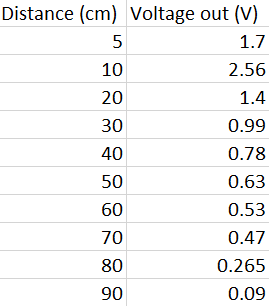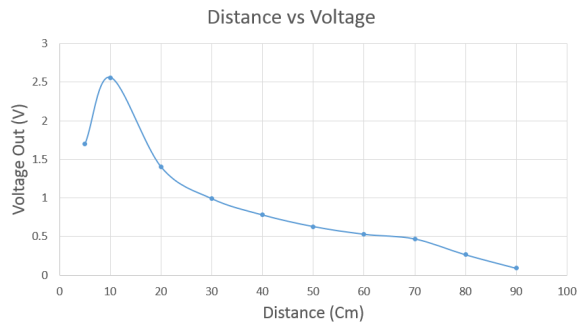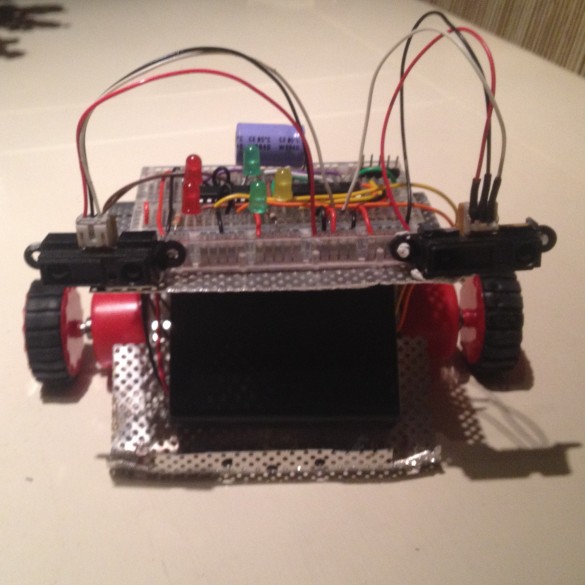In this Project I plan on remotely controlling a two-wheeled car I built via bluetooth.In this project I wanted to make a small two wheeled robot that drives around dodging evrything infront of it.
I mounted two SHARP IR Distance sensors to the front so that the robot can decide which way to turn if an object triggers either sensor.
I used an 18 pin dsPIC30F3012 for this as I wanted to fit the dsPIC and driver chip SN754410NE onto one small breadboard, also the dsPIC30F3012 had all the io I needed.
I used state’s for each circumstance the robot can be in, in each state there are conditions that if occur the program will change to a different state.
The states of the code go as follows:
The output voltage of the infrared sensor was then measured at different distances so that I could decide at what distance I wanted it to turn.
The results were as follows:

Plotted on a graph it looked like this:

Here is a wiring diaram of the circuit:
Here is my code:
// dsPIC30F3012
// The dodgy Robot
// Written by Aron Horan
// The plan of this project is to make a two wheeled robot with two IR sensors
// mounted to the front. The robot will simply drive around dodging objects.
// If the two sensors have a low reading the robot will drive straight,
// if the left sensror goes high and right is low the robot turns right and vise versa,
// if either sensor goes very high the robot will reverse for a second and turn around
#include <xc.h>
#include <stdio.h>
// Configuration settings
_FOSC(CSW_FSCM_OFF & FRC_PLL16); // Fosc=16x7.5MHz, Fcy=30MHz
_FWDT(WDT_OFF); // Watchdog timer off
_FBORPOR(MCLR_DIS); // Disable reset pin
// Function prototypes
unsigned int read_analog_channel(int);
int main()
{
const turn_right = 0, turn_left = 1, forward = 2, turn_around = 3;
int state = forward;
int left_eye;
int right_eye;
int sw = 0;
// Configure UART
U1BRG = 48; // 38400 baud @ 30 MIPS
U1MODEbits.UARTEN = 1; // Enable UART
// Make RB0-3 outputs
TRISB = 0b1111111111110000;
// Configure analog inputs
ADPCFG = 0b1111111100111111;// Only AN6 and AN7 are analog inputs
ADCON1 = 0; // Manually clear SAMP to end sampling, start conversion
ADCON2 = 0; // Voltage reference from AVDD and AVSS
ADCON3 = 19; // Manual Sample, ADCS=9 -> Tad = 10*Tcy = 333ns
ADCON1bits.ADON = 1; // Turn ADC ON
while(1)
{
left_eye = read_analog_channel(6); // read infrared detector
right_eye = read_analog_channel(7); // read infrared detector
if (state == forward)
{
LATB = 0b1010; // motors: left forward, right forward
if (left_eye > 900 && right_eye < 900) state = turn_right;
if (left_eye < 900 && right_eye > 900) state = turn_left;
if (left_eye > 2200 || right_eye > 2200) state = turn_around;
}
else if (state == turn_right)
{
LATB = 0b1000; // motors: left stop, right forward
if (left_eye < 900 && right_eye < 900) state = forward;
if (left_eye > 2200 || right_eye > 2200) state = turn_around;
}
else if (state == turn_left)
{
LATB = 0b0010; // motors: left forward, right stop
if (left_eye < 900 && right_eye < 900) state = forward;
if (left_eye > 2200 || right_eye > 2200) state = turn_around;
}
else if (state == turn_around)
{
LATB = 0b0101; // motors: left reverse, right reverse
__delay32(40000000);
LATB = 0b0110; // motors: left reverse, right reverse
__delay32(30000000);
state = forward;
}
__delay32(300000);
}
return 0;
}
// This function reads a single sample from the specified
// analog input. It should take less than 2.5us if the chip
// is running at about 30 MIPS.
unsigned int read_analog_channel(int channel)
{
ADCHS = channel; // Select the requested channel
ADCON1bits.SAMP = 1; // start sampling
__delay32(30); // 1us delay @ 30 MIPS
ADCON1bits.SAMP = 0; // start Converting
while (!ADCON1bits.DONE); // Should take 12 * Tad = 1.2us
return ADCBUF0;
}
Here are some pictures of the finished piece:
I will have a video of it in action very shortly, im just low on batteries at the moment and can only run it while plugged in, which wouldn’t make a good video…
Had a bit of a disaster with this little poor fellow. Afer driving from Greystones to Dublin on my bike I Arrived into college to find my bag zip open… Dodgbot was gone…
So without further wait I bring to you…..
I ended up having to buy a set of AA NI-MH rechargable batteries as it kept resetting when the motors switched into reverse due to the curent surge and voltdrop.
Still even with these new 1700mAH batteries it was still resetting, so I ended up using a heap of capacitors (2160uF) is was done the trick.
So finally here is a video of it in action:













Very good Aron! The robot looks brilliant. I’m looking forward to seeing the video to see how well it works.
Your implementation of the state machine is nice and neat. It would be great to include a table summarising the states and state transition criteria.
There are one or two small typos which I’d like to get ironed out – perhaps we could take a minute to go through it together during Thursday’s lab?
Great work!
Ted
Thanks Ted!
Pingback: Nimble Dodgebot is Super Skittish
Pingback: rndm(mod) » Nimble Dodgebot is Super Skittish
Pingback: Belgaum news | About Belgaum | Belgaum information | Belgaum district | Belgaum city | Belgaum Hotels | Belgaum People | Belgaum tourism | Belgaum entertainment | Belgaum students | Inside facebook | Hack | make use of | technical news | | Nimble Dodgebot
Pingback: Nimble Dodgebot is Super Skittish — Blog of MPRosa
Pingback: Dodgebot Ágil es super voluble - | Noticias de seguridad informática, ¿qué es la seguridad informática?
Awesome! Thanks for sharing. Brought some ideas into my head and my own project. Looks really cool what you accomplished there.
No problem Kai!
What a great little bot! I love how much personality it seems to have. How well does it react to moving obstacles, like people or pets?
To be honest it just dodges everything… Although I could switch around the states that it follows objects rather than avoids, my poor dog wouldn’t enjoy that though…
Nice, been working on something similar but with just 1 DIY IR sensor, an ATTiny84 and a bought chassis. Other than that it’s really the same. Can’t seem to get the IR sensor working, tested it on an arduino using the serial monitor and it worked there.
What’s that your chassis is made of?
The chassis is perforated alloy, the Sharp IR sensors seem to be quiet noisy, I also had trouble using them in my “mini radar” project in which I found it very hard to get rid of the noise in which i ended up using an Ultra-sonic sensor instead…
Pingback: Motion Tracking on the Cheap with a PIC | ad hocumentation • n. fast, instinctive documentation of ideas and solutions.